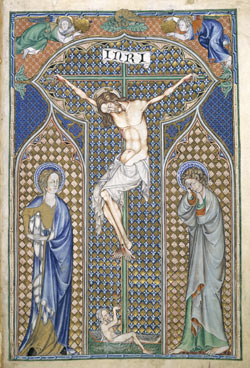|

Mouvance
in the ME lyric:
a case study
 

introduction

 The six
texts edited here, which survive in manuscripts dating from the
thirteenth and fourteenth centuries, offer different versions of a
Middle English verse meditation on the
Passion. The image evoked is of a crucifixion scene, with the Virgin
Mary on one side of Christ, and John, the beloved disciple, on the
other. The six
texts edited here, which survive in manuscripts dating from the
thirteenth and fourteenth centuries, offer different versions of a
Middle English verse meditation on the
Passion. The image evoked is of a crucifixion scene, with the Virgin
Mary on one side of Christ, and John, the beloved disciple, on the
other.
list of
texts

1. Ho
that sith him one the rode (London, British Library, MS Harley 7322,
f. 7r)

2. Quanne Hic se on rode (London, British Library, Royal MS 12 E.
1, f. 194v)

3. Qvanne I zenke onne the rode (Oxford, Bodleian Library, MS Ashmole
360, f. 145vb)

4.
Vyen I o the rode se (Oxford, Bodleian Library, MS Bodley 57, f.
102v)

5. Wenne Hic soe on rode idon (St John's College, Cambridge, MS 15, f.
72r)

6. Wose
seye on rode (Cambridge, Trinity College, MS 323, f. 83v)
top
on-line
tutorial exercise
This exercise, based on the
six texts edited above, is intended as a basis for class discussion (so
there are no answers, only questions). You should start by reading the
accompanying essay on mouvance;
then set aside at least a couple of hours for working through, and
thinking about, the texts, making notes as you go.
Medieval religious lyrics are
usually presented in student editions as single edited texts,
sometimes in modernized or at least standardized spelling, detached from
their manuscript context and the broader history of their textual
transmission (e.g., the edition of poem 2, Quanne Hic se on rode, in
R.T. Davies, ed., Medieval English Lyrics: A Critical Anthology
(London: Faber, 1963), no. 30, p. 99). There are good reasons for this
--- pedagogic as well as practical --- but it can encourage the modern
reader to misconstrue both the function of the poem (can Quanne Hic
se on rode be read in Romantic terms as 'a spontaneous overflow of
powerful emotion', or even equated with works like Donne's Holy
Sonnets?) and its nature (are we really looking at a fixed and
'authorized' text?).
This exercise is designed to
introduce you to the 'work' (or oeuvre, in Zumthorian terms)
which underlies Davies' edited text, by encouraging you to compare its
various surviving manuscript texts, with more editorial support than
most student editions can provide. You will probably find it useful to
go through one of the versions thoroughly first in its on-line edition
(try poem no. 5, Wenne Hic soe on rode idon), and then use it as a basis for comparison with
the others.
For plain
texts of all six lyrics on a single sheet, in Microsoft Word format for
printing out, click on http://www.soton.ac.uk/~wpwt/studytext.doc.
Consider
the following questions:
--- what kinds of variation do you find between these texts? (look at
content, poetic form (including rhyme-schemes), wording, order of
elements ...)
--- is it possible to establish any clear line (or lines) of descent in
this group of texts?
--- does textual variation necessarily involve textual deterioration?
--- what reasons can you suggest for the variation in these texts?
--- what kind of context do you think they were produced in (and for)?
Does their manuscript context give any indication of their likely
function?
--- do these texts have authors? how important is 'authorial intention'
here?
---can you suggest any examples of modern works (literary or
non-literary) subject to mouvance or variance?
Bring your
notes on these points to the class.
home
| contents
| search | top
|